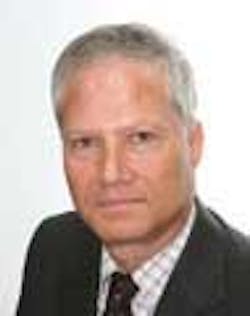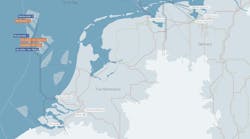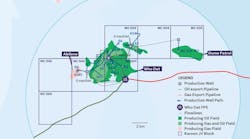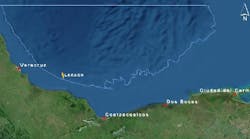Britain's government has introduced a series of measures in an attempt to arrest the slide in UK North Sea activity. These address most of the concerns raised by license operators and their partners during recent consultations.
From Jan. 1 the tax rate on UK offshore production was due to be cut by 2%, lowering the band the industry had been paying from 62-81% to 60-80%. In his December Budget statement, Chancellor George Osborne also introduced a new allowance to stimulate development of ultra high pressure, high temperature oil and gas fields within cluster areas. One of the first likely to benefit will be Maersk's proposed three-platform Culzean development in the central North Sea, which could provide 5% of the UK's gas within four years.
Other proposals included a simpler, basin-wide "investment allowance" in place of the complex existing system of offshore field allowances; financial support for seismic surveys in underexplored offshore areas (thought to include the southern gas basin, where there is the largest concentration of production infrastructure); extending the ring fence expenditure supplement by four years, allowing investors to offset their costs against future production by up to 10 years; and potential transferability of decommissioning tax reliefs.
Industry association Oil & Gas UK welcomed the proposals, although chief executive Malcolm Webb cautioned that further rate reductions would be needed to ensure the UK North Sea's long-term future. "Over the last three years," he pointed out, "exploration activity has slumped, production has decline by 40%, and operating costs have risen by 40%."
The association itself has initiated two projects to stimulate exploration. One is a review, led and funded by Britain's Department of Energy and Climate Change, of wells drilled between 2003 and 2013 in the central North Sea, still thought to contain the UK's largest remaining hydrocarbon potential. The other is a study to be conducted by the British Geological Survey of the Palaeozoic potential throughout the UK continental shelf. Findings from both studies will be included in the 21st Century Exploration Road Map Project, designed to improve exploration success via a comprehensive analysis of the major exploration plays.
Pieter Schelte to conduct topsides lift trials
Perenco has submitted an Environmental Statement of the Thames gas complex in the southern UK North Sea, forst developed in the 1980s, which ceased production in May last year. The submission covers offshore facilities across 13 blocks, and includes the Thames platforms and subsea installations serving four satellite fields.
Allseas' new decommissioning/installation vesselPieter Schelte was due to arrive in Rotterdam harbor early this month following a voyage from Daewoo Okpo's shipyard in South Korea. Allseas has rented a deepwater site where it plans to install the topsides lift beams on the vessel's bows, followed by test lifts on a mock-platform that the company has been building in the southern North Sea. Assuming all goes to plan, the vessel's first job will be to remove the redundant jackup platform from Talisman's Yme field, possibly followed later in the summer by Shell's Brent Delta platform in the UK northern North Sea.
Snorre partners review cost options
Statoil and its partners have opted to delay a second-stage decision on their Snorre 2040 project until October. They still aim to take a final investment decision around one year later, targeting start-up in late-2021. The project involves adding a third platform (Snorre C) at the field in the Norwegian North Sea where production started in 1992.
The Stage-2 delay gives Statoil more time to incorporate results from its internal technical efficiency program, and to implement potential cost improvements. Snorre has a complex reservoir but the potential for increased oil recovery is thought to be one of the largest of any field offshore Norway. When the original development plan was submitted the estimated recovery was 25%. This has since risen to 35%, and the partners are aiming for 54% eventually by adding a third platform and importing gas for reservoir drive.
Farther south, the various licensees in the giant Johan Sverdrup field have recommended that Statoil operate all phases of the development from a production organization to be established in Stavanger. They plan to submit details of this agreement next month to the Norwegian authorities with their plan for development and operation. The first-phase field center will serve for connection of various installations during subsequent phases. In this case, Statoil says, the goal is a recovery factor of at least 70%.
At the Oseberg field center, Statoil has permission from Petroleum Safety Authority Norway to extend use of the Tune gas-condensate field subsea facilities until mid-November 2020. These initially started operating in 2002 – at that time the risers and pipelines had an anticipated lifespan of 14 years.
Ormen Lange in line for southern tieback
Norske Shell has completed drilling an appraisal well on the southeastern edge of the giant Ormen Lange gas field in the Norwegian Sea, 130 km (81 m) northwest of Kristiansund. The semisubTransocean Barents drilled the well 7 km (4.3 mi) from the field's southernmost subsea template in 615 m (2,018 ft) of water.
The aim was to delineate this part of the field to clear up uncertainty over reservoir drainage issues. According to the Norwegian Petroleum Directorate the well intersected a 28-m (92-ft) gas column with an underlying water zone in the "Egga" reservoir unit. The results do not suggest a need for reassessing the recoverable reserves, but the partners will likely consider further development via a tie-in to the subsea template.
Another exploratory well drilled in deeper water, 20 km (12.4 mi) northeast of Statoil's Aasta Hansteen development, has proved gas in the Ivory structure. The Centrica-operated well hit the target in Kvitnos formation sandstones, although the estimated resources of 280 bcf are below expectations, according to partner Rocksource.
Sound prepares bid for Antrim
Plunging oil prices have increased merger speculation in northwest Europe, where many independents are having a hard time attracting capital for their exploration programs. UK-based Sound Oil, which has amassed numerous licenses onshore Italy, has outlined plans to acquire the share capital of Calgary-based Antrim Energy with a view to creating a pan-European oil and gas business with ‘high impact' exploration interests.







